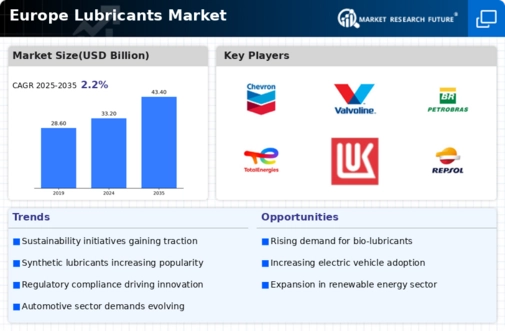The Europe Lubricants Market presents a dynamic and competitive landscape characterized by the presence of diverse key players that cater to a broad spectrum of industries and applications. Various companies are constantly innovating their product offerings to meet stringent environmental regulations while also ensuring optimal performance for a range of vehicles and machinery. The market is driven by increasing demand for advanced lubricating fluids, the shift towards synthetic lubricants, and the growing need for efficiency and sustainability across industry sectors.
Competitive strategies in this market often include mergers and acquisitions, expansion of distribution channels, and investment in research and development to enhance product formulations. As players strive for market leadership, understanding their individual market positioning, strengths, and strategies becomes essential for stakeholders looking to navigate this intricate market landscape.Chevron's position within the Europe Lubricants Market is robust, spurred by its extensive portfolio of high-quality lubricating oils and greases tailored for various applications, including automotive and industrial sectors.
The company's strengths lie in its commitment to innovation and sustainability, as it continuously develops products that not only enhance performance but also reduce environmental impact. Chevron has a strong distribution network across Europe, ensuring that its products effectively reach a wide customer base. Furthermore, the company's focus on customer-centric solutions has fortified its reputation, enabling it to capture and retain a loyal clientele.
While the competitive landscape is challenging, Chevron's strategic initiatives and strong brand equity have allowed it to maintain a significant presence in the market.Valvoline also holds a prominent position in the Europe Lubricants Market, recognized for its wide range of products that include engine oils, transmission fluids, and other automotive maintenance solutions. Its robust market presence derives from a well-established reputation for quality and performance, fostering trust among consumers and industrial clients alike. Valvoline is committed to ongoing innovation, often introducing cutting-edge products designed to meet the evolving demands of the automotive sector.
The company has made strategic decisions to enhance its market share, including targeted mergers and acquisitions that expand its service offerings and geographical reach within Europe. Valvoline's focus on developing environmentally friendly products has further reinforced its competitive edge, aligning with the regional shift towards sustainability. Through its effective marketing strategies and commitment to operational excellence, Valvoline continues to solidify its footprint in the competitive landscape of the Europe Lubricants Market.
























Leave a Comment